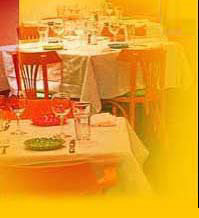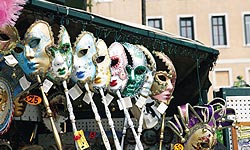 When you stop at the many carts in the streets of Venice you invariably end up looking at the display of masks. And they are everywhere, in shops small and big. Simple and ordinary ones to beautiful, elaborate, very fancy ones.
When you stop at the many carts in the streets of Venice you invariably end up looking at the display of masks. And they are everywhere, in shops small and big. Simple and ordinary ones to beautiful, elaborate, very fancy ones.
So what is the origin of these masks, why are they so associated with Venice?
 These are carnival masks, the hallmark of il Carnevale di Venezia. Venice's Carnival began in the 11th century, and the wearing of masks and costumes became well established by 1436, when maskmakers or mascareri were officially recognized by their own guilds.
These are carnival masks, the hallmark of il Carnevale di Venezia. Venice's Carnival began in the 11th century, and the wearing of masks and costumes became well established by 1436, when maskmakers or mascareri were officially recognized by their own guilds.
The practice of wearing masks for disguise reached its zenith in the 18th century, when Venetians of different social classes used the Carnival as an excuse to mingle and, in some cases, to trade sexual favours without fear of recognition or retribution. (With a mask, a silk hood, a tabarro cape and a tricorn hat,  a housewife in search of some fun, was as indistinguishable from a nobleman on the prowl).
a housewife in search of some fun, was as indistinguishable from a nobleman on the prowl).
Masks virtually disappeared along with the Carnevale when Napoleon's troops brought an end to the Venetian Republic in 1797. However, they've staged a spectacular comeback since a group of former Academy of Fine Arts students opened Venice's first modern mask shop in 1978.
 Today's Venetian masks serve two functions: as souvenirs or craft objects to take home from Venice or as vehicles for self-expression and self-display during the Carnival, or Carnevale, which takes place every February (the dates for 2009 are 13 to 24 and in 2010 its February 5 to 16). The Carnival is Venice's answer to Mardi Gras and Fasching.
Today's Venetian masks serve two functions: as souvenirs or craft objects to take home from Venice or as vehicles for self-expression and self-display during the Carnival, or Carnevale, which takes place every February (the dates for 2009 are 13 to 24 and in 2010 its February 5 to 16). The Carnival is Venice's answer to Mardi Gras and Fasching.
 For eight days before Lent each winter, tourists flood the city for an orgy of pageants, commedia dell'arte, concerts, balls, and masked self-display until Shrove Tuesday signals an end to the party. The term "carnevale" comes from the Latin for "farewell to meat" and suggests a good-bye party for the steaks and stews that Catholics traditionally gave up during the weeks of fasting before Easter.
For eight days before Lent each winter, tourists flood the city for an orgy of pageants, commedia dell'arte, concerts, balls, and masked self-display until Shrove Tuesday signals an end to the party. The term "carnevale" comes from the Latin for "farewell to meat" and suggests a good-bye party for the steaks and stews that Catholics traditionally gave up during the weeks of fasting before Easter.



 The Mystique Of The Venetian Masks
The Mystique Of The Venetian Masks

 When you stop at the many carts in the streets of Venice you invariably end up looking at the display of masks. And they are everywhere, in shops small and big. Simple and ordinary ones to beautiful, elaborate, very fancy ones.
When you stop at the many carts in the streets of Venice you invariably end up looking at the display of masks. And they are everywhere, in shops small and big. Simple and ordinary ones to beautiful, elaborate, very fancy ones.  These are carnival masks, the hallmark of il Carnevale di Venezia. Venice's Carnival began in the 11th century, and the wearing of masks and costumes became well established by 1436, when maskmakers or mascareri were officially recognized by their own guilds.
These are carnival masks, the hallmark of il Carnevale di Venezia. Venice's Carnival began in the 11th century, and the wearing of masks and costumes became well established by 1436, when maskmakers or mascareri were officially recognized by their own guilds.  a housewife in search of some fun, was as indistinguishable from a nobleman on the prowl).
a housewife in search of some fun, was as indistinguishable from a nobleman on the prowl). Today's Venetian masks serve two functions: as souvenirs or craft objects to take home from Venice or as vehicles for self-expression and self-display during the Carnival, or Carnevale, which takes place every February (the dates for 2009 are 13 to 24 and in 2010 its February 5 to 16). The Carnival is Venice's answer to Mardi Gras and Fasching.
Today's Venetian masks serve two functions: as souvenirs or craft objects to take home from Venice or as vehicles for self-expression and self-display during the Carnival, or Carnevale, which takes place every February (the dates for 2009 are 13 to 24 and in 2010 its February 5 to 16). The Carnival is Venice's answer to Mardi Gras and Fasching.  For eight days before Lent each winter, tourists flood the city for an orgy of pageants, commedia dell'arte, concerts, balls, and masked self-display until Shrove Tuesday signals an end to the party. The term "carnevale" comes from the Latin for "farewell to meat" and suggests a good-bye party for the steaks and stews that Catholics traditionally gave up during the weeks of fasting before Easter.
For eight days before Lent each winter, tourists flood the city for an orgy of pageants, commedia dell'arte, concerts, balls, and masked self-display until Shrove Tuesday signals an end to the party. The term "carnevale" comes from the Latin for "farewell to meat" and suggests a good-bye party for the steaks and stews that Catholics traditionally gave up during the weeks of fasting before Easter.